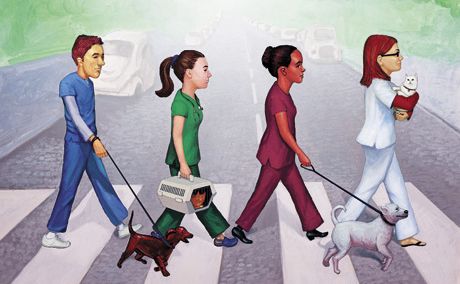Come together to work with veterinary shelters
Life is very short, and theres no time for fussing and fighting, my friend. Whether you work in private practice or at a shelter, its time to come together right now for pets. All you need is love.

Everybody's talking about low-cost spays and neuters, competition, legislation, revolution, regulation. All we are saying is give peace a chance. On the following pages, you'll find tips, tools and insights to connect with your colleagues-whether they work in shelters, for rescue organizations or in private practice-and improve the lives of pets and the people who love them.
Did You Know? Shelter medicine VTS quick facts
In April 2014 the American Board of Veterinary Practitioners approved a shelter medicine specialty for veterinarians. The next step: include the credentialed veterinary technicians who work with these veterinarians, says Liza W Rudolph, BAS, CVT, VTS (CP, SAIM), a member-at-large (Canine/Feline) and credentials committee chair for the Academy of Veterinary Technicians in Clinical Practice (AVTCP). Once the organizing committee is finalized, it typically takes about two to five years for the process to become available to applicants.“I'm recruiting members to form an organizing committee and will function as an advisor during their petition process,” Rudolph says.
The specialty will likely focus on skills including vaccination protocols, infection control, housing, sanitation, behavior, shelter facility design and operation, public health and veterinary forensics. Visit dvm360.com/shelterspecialty for links to the general application VTS checklist, information on shelter medicine and details about AVTCP.
Case study: Rescues and pets and veterinary teams make three
With shelters in the Portland area often at capacity, the veterinary team at Cedar Mill Veterinary Hospital in Portland recently launched a program to help increase adoption rates-and improve the wellness care pets receive throughout their lifetimes.
The practice's plan: Offer a free wellness exam within the pet's first six months of adoption. Pets also receive free deworming medication during the initial exam as well as heartworm and FELV/FIV tests for half off within the first two months of the initial exam.
“Being generous with our discounted services for people adopting pets rewards people for doing a good thing. It helps pet owners get through the initial preventive care that is so important for the well-being of our pets and their families without having costs factor in nearly as much as they could otherwise,” says Alec Bailey, DVM, a veterinarian at Cedar Mill Veterinary Hospital. “By helping people who are adopting pets, we are also hopefully helping the local animal shelter and pet rescue community.”
Outreach: Their receptionist researched rescue groups in the area. When they had established a comprehensive list, the three veterinarians divided the list and called the rescue groups to outline their plan to shelter organizers.
The bonus: The program also helps attract new clients. “Success at our hospital comes from being an established part of our community and from building lasting, multigenerational relationships with our clients. We are hoping that our new adopted pet plan will allow us to develop more of these strong relationships,“ Dr. Bailey says.
What's the emotional toll of shelter work?
This really depends on the shelter, the policies, euthanasia rates, support systems and so on. We often think of shelter employees but our volunteers can also experience compassion fatigue. I have participated in several lectures and discussions over the years on this topic. Burnout is also a risk. I'm not an expert here. However, my take-home message has always been that one must lead a balanced life of family, friends, other hobbies and so on. Although it's important to be passionate about the veterinary profession and shelter medicine more specifically-and animal lives may very well depend on our attitude-without a balance of other interests the emotional toll can have dire consequences. My main message and homework assignment to my veterinary students at the end of each week is for them to report on Monday what nonveterinary activity they participated in over the weekend.”
-Frank Bossong, DVM, serves on the board of directors at the San Gabriel Valley Humane Society in San Gabriel, California, and is an assistant professor at the College of Veterinary Medicine at Western University of Health Sciences in Pomona, California.
A quick how-to to build your own program:
1. Be honest with yourself, your team and your clients. You can help pets find a good home and start them off with necessary veterinary care as well as develop a relationship with a veterinary hospital. “We can feel good about doing this,” Dr. Bailey says. “That being said, we can't afford to give away services without some return. And by meeting with and earning the trust of new clients, our hospital will form bonds with long-term clients and patients.”
2. Outline your plan clearly. Decide what you're willing to offer as a discount, and communicate this clearly with your team so you can implement it consistently. For example, Cedar Mill made up a handout they passed out to shelters and rescue groups that detailed their plan. They also posted their plan on their website.
3. Reach out to groups in your area that are involved with pet adoption. Let them know that you support the good work they do, and ask them to include your hospital on their list of preferred veterinary practices. It's also a good idea to ask them to keep the handout outlining your plan on hand to offer to adopting families in your area.